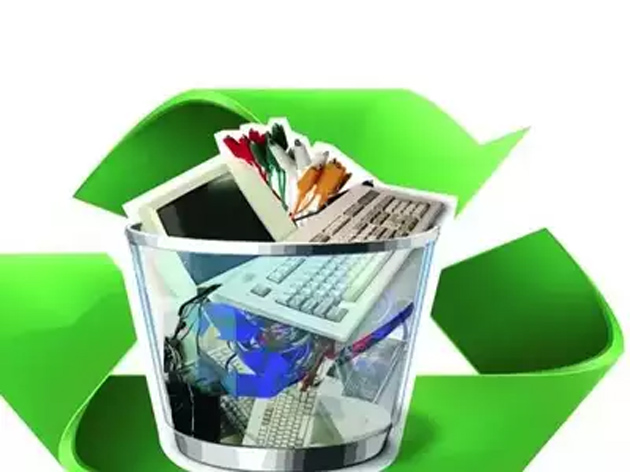K R Sudhaman
After successful swachhata campaign by Prime Minister Narendra Modi government during the last 2-3 years to clean up government ministries and buildings by getting rid of musty files and condemned scrap furniture, Coal ministry has shown the way to convert this waste into wealth. “Kabad se Kalakrity”, a novel initiative has been launched by the ministry as part of the centre’s special swachhata campaign 3.0 from October 2-31 to turn scrap into sculpture.
The Jamuna Kotma colliery in Madhya Pradesh has created sculptures using various scrap materials and installed them in a public park. This has not only tackled the problem of scrap disposal but also helped in utilizing them for beautifying parks and providing employment to artisans. This is one such example of innovative ideas to deal with waste and scrap material that has surfaced in the wake of cleaning up campaign in various government buildings. This has already earned over Rs 700 crore revenue as well during the last three years.
This swachhata campaign has been undertaken as part of the government’s administrative reforms and campaign 3.0 has received overwhelming response as compared to the previous two such campaigns in 2022 and 2021. There are several success stories under special campaign 3.0. The Public enterprises BHEL, has embarked upon clean water campaign and Global automotive research centre in Chennai organized a drawing competition to promote the importance of cleanliness and hygiene among school going children. The Braithwaite Burn and Jessop construction company organized meditation campaign and plantation of sapplings in heavy plant yard after removing the junk and scrap material from there. The armed forces too participated in a big way, especially Western and Southern Naval command, Indian Air Force, various commands of the Army and every armed forces centre organized some programme as part of the campaign to make cleanliness as part of the day to day routine.
One initiative that has gone unnoticed is the launch of digital special campaign by the central government’s administrative reforms and public grievances department to make this an all India effort. The digital campaign launched by minister of state in the department Jitendra Singh in end September has gone unnoticed. The main focus is to revolutionizing service delivery and grievance redressal across India.
This is one service in government, which has not earned accolades in view of general lethargy and apathy by government servants in dealing with the public. Government usually is not known for Service delivery. Stonewalling has been mastered by bureaucracy and politicians in India, which they have learnt well from the British colonial power. The union government might be slightly better than state governments where service delivery is appalling. Some states like Tamil Nadu, Maharashtra and Gujarat fair slightly better.
Hopefully, this digital campaign launched by Jitendra Singh brings about changes in mindset and approach to service delivery in the government. It is not that all service delivery in government is bad. Some are good and there are some exceptions as well but by and large the approach is lackadaisical and the change can come about only by a sustained campaign.
According to Singh, the overarching theme of this digital campaign is to promote unified service delivery portals nationwide, reducing pending public grievances, harnessing Artificial intelligence and emerging technologies for effective grievance resolution. This will also advocate sustainable practices and ensure efficient record management offices. Record management has remained pathetic though there are some visible improvement since digitization began some years ago.
The use of Artificial intelligence helps in reducing fatigue among staff in carrying out mundane activities thereby improve efficiency. This is quite visible in filing of income tax returns and getting refunds in recent years with the adoption of faceless filing of income tax returns a few years ago.
Singh said the unified service portal will help in streamlining and digitizing government services, making them more accessible to citizens. In consultation with states, he said, the government has identified 164 services that could be delivered on a pan-India basis as e-Services, in addition to the existing 56 mandatory e-Services.
Singh said the states and union territories also discussed transitioning offline services to online platforms, emphasizing the need for faceless and proactive service delivery. Currently states and union territories offer 14,736 e-services, with Jammu and Kashmir leading the way with 1028 e-services. Singh hails from Jammu region. The average grievance resolution time across all ministries and departments stands at 19 days. This may be an improvement over the previous years but there is still a long way to go.
With the adoption of artificial intelligence and emerging technologies will help in speeding up grievance resolution. According to Singh, the intelligent Grievance Monitoring system dashboard developed in collaboration with IIT Kanpur leverages Artificial intelligence capabilities to provide instant analysis of grievances filed and disposed of, along with state-wise , district-wise and ministry-wise data.
This technology will assist officials in identifying the root causes of grievances, leading to more effective resolutions, Singh said adding Bharat GPT team led by IIT Mumbai is developing India specific large language model for the public grievances digital platform.
With the launch of this digital campaign, the department has successfully resolved 145 public grievances, reviewed 100 per cent of their files, identified 447 physical files for disposal and completed the weeding out process of 140 files. Further, 1317 e-files have been identified for closure, with all of them successfully closed in the e-office. All these have been achieved within one week of the launch of the campaign and it would only grow in the coming weeks and months. (IPA )


